Y11 Prelim Ancient History Syllabus Summary's
TUTANKHAMUNS TOMB
focus - to investigate Tutankhamuns tomb & what it reveals about the past
● representations of Tutankhamun – ancient and/or modern, for example ‘Tutmania’ and the ‘mummy’s curse’
Ancient Representations
He restored Egypt to it’s old religion during his reign
He was discredited soon after his reign, and removed from official records.
The discovery of his tomb was able to open the eyes of archeologists to the world of Ancient Egyptian life through many treasures and art
Modern Representation of Tutankhamun
Tutmania
The discovery of Tutankhamun’s tomb changed the worlds view on Ancient Egyptian life. With newspaper articles being published everywhere, everyone knew what was being discovered in Egypt. With the discovery happening at the start of the ‘Roaring Twenties’ when there was a big focus on world events, news and money/riches!!
Egyptian motifs appeared everywhere in architecture, art, jewellery and fashion in the 1920’s. The Art Deco style greatly leaned on the Ancient Egyptian architecture styles.
Lots of novels, plays, movies and music came out of this time period. The film, The Mummy, from 1932, and it’s 2017 reboot, both lean heavily into Tut-mania.
Read Chapter 8.7 and Source 28 in Antiquity Y11 Textbook.
Curse of the Pharaohs
Improbable Events occurred around the discovery of Tutankhamun’s Tomb that made people think a supernatural force could be involved and working
A Cobra, a symbol of Pharaohs power, attacks Howards canary the day of the tombs discovery
Lord Carnarvon died of pneumonia shortly after they opened the tomb
The lights of Cairo went out when Carnarvon died
Canarvons dog, Suise, dropped dead at the same time
This ‘evidence’ sent the media into a frenzy. But many facts, like Howard Carter living to 64, and the curse not following objects once removed from the tomb, contradict this idea.
Tut’s name and image have appeared in a range of media, for example in songs, historical novels and movies. His story is an icon of popular culture.
Tutmania:
· Was expressed in various media during the 1920s and even later.
· The tomb’s discovery at the start of the 1920s followed the global upheavals of WWI and mass media was able to bring news of objects being carried out of the tomb to a wider audience.
· Media promotion and speculation, surrounding the discovery of Tut’s tomb, enhanced that of the public during the dark years of WWI, creating Tutmania. It was basically a craze over Tut and gave hope during WWI.
· Egyptian motifs appeared everywhere in architecture, art, jewellery and fashion in the popular art deco style.
· E.g., interiors and exteriors of buildings featured papyrus columns and lotus friezes, while women wore necklaces decorated with scarab beetles, winged goddesses and sphinxes.
· Novels and plays based on Egyptian themes, featuring archaeologists, tombs, and especially mummies.
· Films released during this time such as The Mummy a horror film which was later made into a franchise as in 2017 The Mummy featured Tom Cruise. This shows the longevity of the mummy as a monster motif, originating with the discovery of Tutankhamun’s tomb.
· Harry Von Tilzer has a 1923 song called ‘Old King Tut’. This song came out as the Charleston was becoming the most popular dance.
Tutankhamun tours the world:
· In the latter half of the 20th century, artefacts from Tut’s tomb began to be exhibited around the world.
· A new wave of Tutmania arose however, The Treasures of Tutankhamun, a ‘blockbuster’ exhibition toured between 1972 and 1981.
· The Egyptian government attempts keeping the famous golden mask and the mummy of the pharaoh permanently in Egypt due to their fragile nature.
Tutankhamun’s curse:
· As well as Tutmania, the opening of Tut’s tomb gave birth to the phenomenon of the ‘mummy’s curse’.
· A series of improbable coincidences appeared to point to supernatural interest in the event.
· E.g., a cobra, the symbol of the pharaoh’s power, attacked and swallowed Howard Carter’s pet canary on the day that Carter discovered the tomb.
· In the April following the tomb’s discovery, Lord Carnarvon died from pneumonia. While shaving, he had nicked a mosquito bite on his cheek, which led to infection and fever.
· The lights of Cairo apparently went out at the time of Carnarvon’s death.
· Carnarvon’s dog, Susie, dropped dead at the same time.
· This ‘evidence’ sent the world’s media into a frenzy of speculation about the existence of a curse.
· As the years passed, a range of people who had been closely or even vaguely associated with the tomb’s opening died (in a range of different ways), fulfilling further speculation.
· The facts seem to contradict those who believe in the mummy’s curse as Howard Carter himself lived until 64 years old and died in 1939. Others closely involved lived longer lives, dying in their eighties.
● the significance of Tutankhamun’s Tomb

● the geographical and historical context, including:
an overview of New Kingdom Egypt, the religious crisis and mystery of the pharaonic line at the time of Tutankhamun
· Tutankhamun was born in ancient Egypt in approximately 1341 BC in a period we call the New Kingdom.
· Around 1333BC Tut came to the throne as an 8 or 9-year-old.
· New Kingdom: 1550-1050 BC, started in the 18th Dynasty.
· The pharaohs of the emerging New Kingdom expelled the foreign Hyksos kings and began a program of military expansion and domestic consolidation of power.
· Thutmose I, Thutmose III and Amenhotep II established Egyptians military power north of the Euphrates river and south into Nubia.
· Amenhotep III’s building program provided Egypt with many beautiful palaces and temples.
· Amenhotep IV changed the state religion from worship of the god Amun ‘the hidden one’ to worship of the Aten, the disc of the Sun, and changed his name to Akhenaten.
· Tutankhamun’s reign saw a return to the orthodox worship of Amun, after the death of Akhenaten.
Pharaonic line:
· DNA testing in 2009 was carried out on Tut’s remains and those of 11 other mummies.
· The results confirmed that Tut’s father was Akhenaten.
· They also revealed Tut’s mother was a ‘Younger Lady’ whose DNA indicated she was the daughter of Amenhotep III and his wife Tiye, who were also Akhenaten’s parents, which meant Tut was the child of a brother-sister relationship which wasn’t uncommon in the Egyptian royal family of the New Kingdom period.
· However, the results of the tests were contested by the French Egyptologist Marc Gabolde in 2013, who claimed in his opinion that Nefertiti and Akhenaten were first cousins and the ‘Younger lady’ was Nefertiti. However, Nefertiti’s mummy has never been absolutely identified.
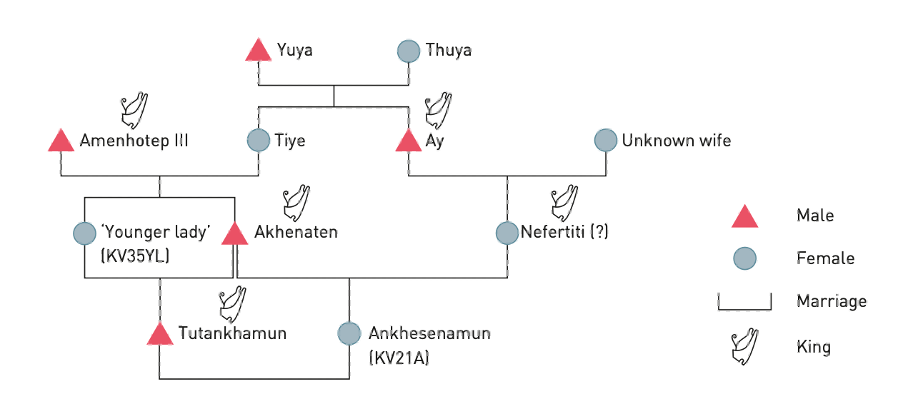
The religious crisis:
· Amenhotep IV changed the state religion from worship of the god Amun ‘the hidden one’ to worship of the Aten, the disc of the Sun, and changed his name to Akhenaten.
· He also moved the religious temple from Luxor to Armana, and made it illegal to worship any gods other than Aten.
· Tutankhamun’s name was Tutankhaten, but he changed it back when he became Pharaoh after his father’s death.
· Tutankhamun’s reign saw a return to the orthodox worship of Amun, after the death of Akhenaten.
discovery and excavation of the tomb by Howard Carter
¨ Discovered 1922 by Howard Carter with his sponsor Lord Carnarvon
¨ Found in the Valley of the Kings which is the royal cemetery on the west bank of the Nile in Thebes (where the sun goes down/dies symbolising the dead)
¨ From 1917 to 1921 there was little success and Carnarvon threated to withdraw his sponsorship, however, Carter persuaded him to continue for another season and offered to pay for the last attempt himself.
¨ The top of the staircase was uncovered in the last part of the valley unexplored on the 4th of November 1922.
¨ Carter could not go any further with the opening of the tomb until Lord Carnarvon and his daughter arrived.
¨ The plastered door bared seal impressions of Tutankhamun’s names.
¨ Evidence that the tomb had been robbed as there were three separate entries in the corridor.
¨ Carter was different with his excavation and was unlike other archaeologists who quickly cleared the tomb of its artefacts.
¨ He gave each artefact a reference number and took pictures of the in situ (with and without the reference number).
¨ A numbered record card was made, along with a brief sketch and description of artefact. The artefact’s position was recorded on a ground plan of the tomb.
¨ The artefact was removed to the laboratory tomb where it was photographed against a neutral background and preserved and/or conserved.
¨ When this process was completed, the artefacts were carefully crated and transported to Cairo.
● the range of sources, including:
the structure and key features of Tutankhamun’s tomb
¨ Not as lavish because he didn’t have as long of a reign to prepare his tomb.
¨ Rock-cut tomb excavated deep into the limestone cliffs of the Valley of the Kings.
¨ Small and lacked some elaborate features compared to a normal royal tomb of the 18th Dynasty.
¨ Consisted of staircase entrance, corridor, antechamber, annex, burial chamber, treasury.
¨ All of the artefacts and the Pharaoh were still there, although some could have been stolen when being put in, but since the tomb was covered in rubble from landslides and flooding dried up, it was never found in antiquity to be robbed post-burial.
tomb paintings and artefacts
— canopic chest
¨ ritual artefacts – protect pharaoh in safe arrival into afterlife.
¨ Everyday items – clothing and jewels to wear, royal regalia, chairs, beds, games, chariots and weapons to hunt with, lamps, food and drink.
¨ Burial goods: the artefacts found within the tomb.
¨ Wine jars found in Tutankhamun’s tomb are labelled with the years of his reign. As the King’s mummy proves that he died around eighteen to nineteen years old and the oldest of the wine jars is labelled “year 10”, it has been deduced that the throne was inherited by Tutankhamun at eight years old in c1336 BC.
¨ The warrior iconography on the wooden chest, found in the antechamber, not only paints a picture of Tutankhamun’s life, but also a typical pharaoh’s role of upholding ma’at. This is reflected through the depictions on the chest of Tutankhamun defeating the Nubian and Syrian soldiers, him trampling enemies as a sphinx and hunting wild animals. The ‘warrior pharaoh’ iconography of a standard New Kingdom pharaoh is demonstrated through the scenes of war, which also exhibit the types of chariotry, and weapons used and the enemies of the Egyptian army.
¨ The wall paintings were only in the burial chamber, compared to in most royal tombs being everywhere.
¨ Images of the funeral procession, the ‘Opening of the Mouth’ ceremony, and the Pharaoh being welcomed into the afterlife by deities.
the condition of the human remains found in the tomb
¨ Only mummy to still be found in his tomb intact.
¨ Not in good condition.
¨ Because of the copious amounts of resin that the embalmers poured over his body and wrappings, the resin could self-heat. The mummy was stuck to the inner solid gold coffin, and he had to be sliced in half to be taken out. As well as the body being a charred wreck because the resin was self-heating and the more surface area the hotter it could get.
¨ His bandages had been reduced to soot.
¨ When an examination was made on his mummy by Dr Carter, he recounted that there was a large gash or incision made to open up his insides in the mummification process when it only had to be a small one.
● burial customs at the time of Tutankhamun as revealed through the sources, including:
– the evidence for funerary beliefs and practices: deities, afterlife, funeral procession
Painted scenes in burial chamber depicted:
· the ‘Opening of the Mouth Ceremony’
· Funeral procession
· The pharaoh being welcomed into the afterlife by a range of deities
Burial furniture and possessions show belief that would need them in afterlife:
· Ritual artefacts designed to protect the pharaoh and ensure his safe arrival in afterlife
· Clothing, jewels, royal regalia
· Chairs, beds, games, lamps
· Chariots, weapons
· And food and drink
Other:
· Painted wooden chest that has inscriptions of ‘good god, son of Re’, showing beliefs in deities, and depictions of Pharaoh defeating enemies shows belief in ma’at and the Pharaoh’s role in upholding it.
· Ka statues show belief in souls traveling to afterlife.
– the nature of mummification
¨ Brain extracted through the nostrils with an iron hook. What the hook cannot reach is rinsed out with drugs.
¨ Flank is laid open with flint knife and whole contents of abdomen removed.
¨ Cavity is cleansed and washed out, first with palm wine and then with an infusion of pounded spices.
¨ Cavity filled with pure bruised myrrh, cassia, and every other aromatic substance with the exception of Frankincense.
¨ The body is sewn up and placed in natrum, covered entirely over, for seventy days.
¨ Body is washed and wrapped head to foot in linen cut into strips and smeared on the underside with gum – instead of glue.
¨ The body is given back to the family and is put in a wooden case shaped for a human figure.
– the limitations of the evidence for Tutankhamun’s life and reign
There are limitations of the evidence for Tutankhamun’s life and reign because of a political reason: Remises II wanted to erase Akhenaten, Tutankhamun and Ay from history by skipping them in the list and record of all the pharaohs in the temple of Seti I at Abydos.
– the methods and results of scientific analysis/forensic techniques: CT scans and DNA testing, new theories about Tutankhamun’s life and causes of death
· In 1978, a blood analysis was undertaken by James E. Harris, with combined results of Tutankhamun’s and other royal mummies’ DNA that indicated he was closely related to Amenhotep III, Akhenaten, Sitamun and Tiye.
· In 1968, X-rays done by R.G. Harrison on Tutankhamun’s skull which revealed the deposits of resin introduced into the skull after brain removed in mummification process. Seemed to be a bone fragment and thickened areas at the base of the skull, which led to scholars speculating his cause of death was a blow to the back of the head. This was ruled out in later CT scans. The X-rays also revealed that Tut’s breastbone or sternum and some of his ribs were missing, which made them speculate his cause of death was a chariot accident or birth defect. Later by CT scans they ruled this out and that the body parts were taken out by Carter and his team.
· CT scans in 2005 by Dr Zahi Hawass confirmed his age as 18 or 19 when died, as well as height and general health.
· A project undertaken by Dr Zahi Hawass, called the Tutankhamun Family Project from 2007-2009 investigated many royal mummies which underwent anthropological, radiological and genetic examination. It was believed before these examinations that Tutankhamun had a pathological shape to his skull, however, this was contested through the project. The results revealed that the Pharoah had a cleft palate, scoliosis, a club foot and Köhler disease II. He also suffered from malaria, or plasmodium falciparum, along with four of his other family members.
– 21st-century archaeology and ethical issues in the preservation and examination of Tutankhamun’s remains
· According to ancient Egyptian burial beliefs, once the mummy was interred in its sealed tomb it was to remain undisturbed for eternity. Ancient Egyptians believed the disturbance of the dead threatened the deceased’s survival in the afterlife.
· Today, scientific investigation of the dead is strictly regulated by ethical considerations.
· Today, the violent treatment by Howard Carter and his team in removing the mummy from its coffin would be out of the question.
· Egyptian law forbids the unwrapping of any mummy without special permission.
· The examination and preservation of mummies must now be conducted by x-rays and other scientific methods without disturbing the wrappings.
PALMYRA & THE SILK ROAD
Relationship with Rome
palmyra - the city of palm trees
● representations of Palmyra – ancient and/or modern
Ancient Representations:
Temple of Bel and Baal Shamin:
The Temple of Bel was the most significant religious structure in Palmyra, dedicated to the Mesopotamian god Bel and the divine triad (Bel, Yarhibol, and Aglibol). The temple was surrounded by Corinthian columns, a mix of Greco-Roman and Eastern architectural styles.
The Temple of Baal Shamin was dedicated to the Canaanite sky god Baal Shamin. This temple also featured a blend of Near Eastern and Greco-Roman elements, showcasing the cultural syncretism of Palmyra.
Funerary Portraits:
Funerary portraits from Palmyra display a fusion of styles, incorporating features such as Persian eyes and Greek clothing, symbolising the city's cultural diversity.
Relief of Marley and Bolaia: This bas-relief sculpture exemplifies the artistic diversity of Palmyra, combining Persian and Greek influences.
Coins and Inscriptions:
Zenobia’s Coins: Coins minted during Queen Zenobia’s reign depict her and her son Vaballathus with imperial titles, reflecting her opposition to Roman rule and the assertion of Palmyrene independence.
Source 2 -

ISIS & Movies
ISIS troops were heavily
Modern Representations:
UNESCO World Heritage Site:
Palmyra is recognised as a UNESCO World Heritage site for its outstanding universal value, representing a unique blend of Greco-Roman and Eastern architectural and cultural influences.
Modern Destruction and Restoration:
Palmyra has been subjected to significant destruction due to the Syrian Civil War, particularly the demolition of key structures like the temples of Bel and Baal Shamin by ISIS in 2015. Restoration efforts are ongoing to preserve what remains of this historical site.
● the geographical and historical context, including:
– the location of the site of Palmyra
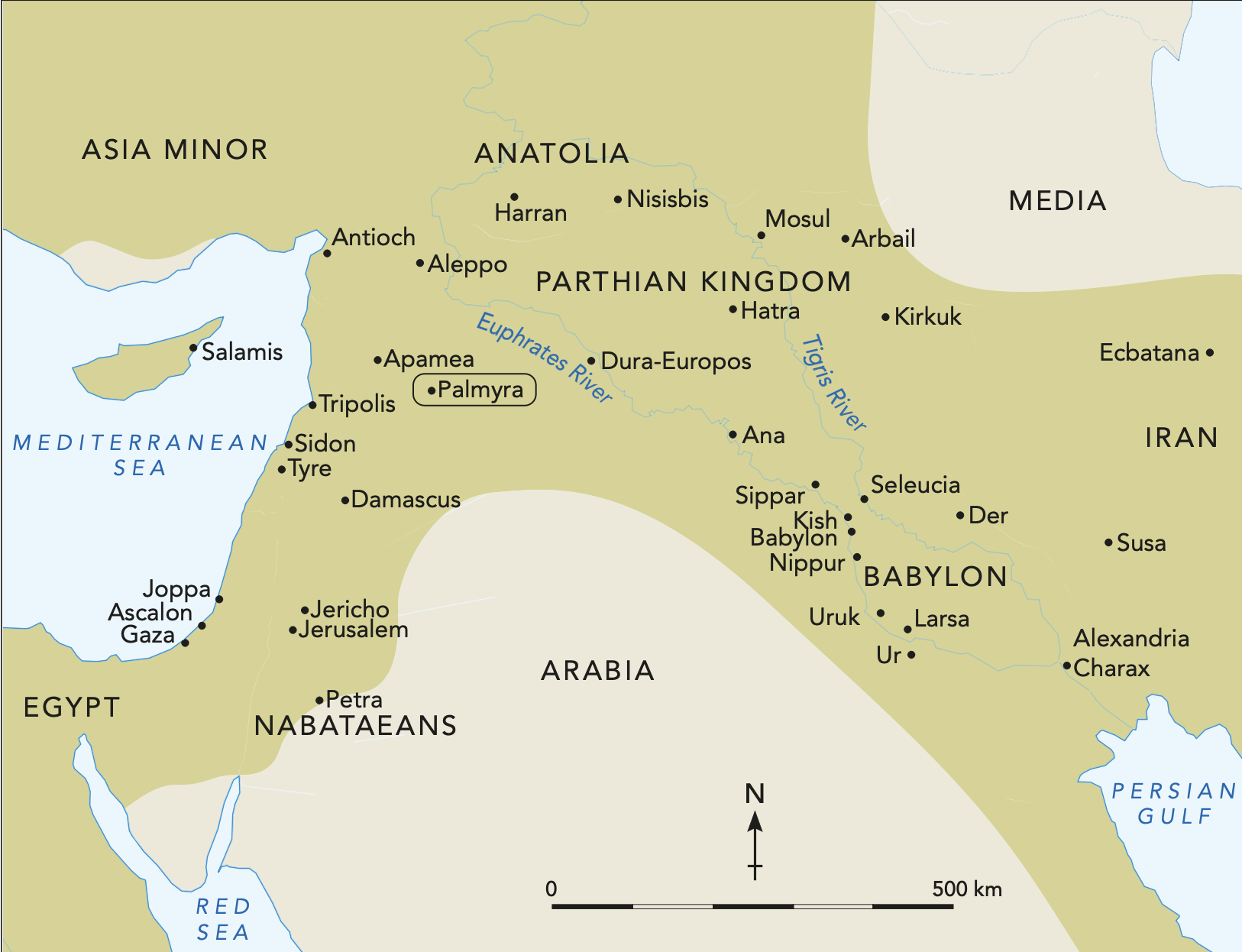
In the Parthian Kingdom, Asia Minor. Near Damascus along the silk road leading to Arabia and opposite the Mediterranean Sea & Euphrates River.
Location of Palmyra:
Palmyra, known in antiquity as Tadmor, is located in the Tadmorean Desert, in present-day Homs Governorate, Syria. The city lies midway between the Euphrates River and the Mediterranean Sea, an oasis in a palm-fringed area, strategically positioned on the Silk Road.
The city’s location between the Roman Empire to the west and the Parthian Empire to the east gave it significant strategic and economic importance, acting as a buffer and a connector between these major powers.
– the development of the city from an agricultural village to the hub of the Silk Road
Began as a staging point for caravans travelling between the Mediterranean, Mesopotamia and Arabia
Buffer between Rome & Parthia trade routes from the east & west
Was then declared a ‘free city’ and they began collecting their own taxes.
AD 167, a roman garrison was established
AD 212, became a Roman colony under Emperor Caracalla
AD 267, Zenobia assumes power
AD 271, Palmyra besieged
AD 527, Palmyra primarily becomes a military outpost
AD 632, Palmyra conquered by a Muslim army
Agricultural Beginnings:
Palmyra began as an agricultural settlement, benefiting from the nearby Efqa spring, which provided a reliable water source in the arid environment of the Syrian Desert.
Transformation into a Trading Hub:
The city’s isolation allowed it to gain political independence, and its strategic location on the Silk Road facilitated its development into a key trading post by 14 CE under Roman Emperor Tiberius.
As a 'caravan city,' Palmyra became a central point for the exchange of goods, culture, and ideas between the East and West. The city's merchants were instrumental in establishing and maintaining trade routes that connected China, India, Persia, and Rome.
– significance of the Silk Road and the nature of trade
The Silk Road:
The Silk Road was a network of trade routes that connected the East and West, stretching from China to the Mediterranean. Palmyra’s location on this route made it a pivotal point in the exchange of goods, including silk, spices, precious metals, and luxury items.
Trade Goods:
From the East: China provided silk, tea, and porcelain, while India contributed spices, jewels, and ivory.
From the West: Rome supplied gold, silver, and glassware, while the Middle East traded carpets, perfumes, incense, and oils.
Cultural Exchange:
The Silk Road was not only significant for trade but also for the cultural exchange it facilitated. Palmyra played a key role in the dissemination of ideas, technologies, and religious beliefs, such as Buddhism spreading from India to China.
● the range of sources, including:
– archaeological sources, eg the Great Colonnade, the Tariff Court, tombs, Temple of Bel and Baal Shamin, the Theatre, roads, coinage
ARCHELOGICAL SOURCES
Great Colonnade
A colonnaded avenue linking the Temple of Bel & The West Gate via the Monumental Gate. With corinthian style columns featuring decorated and inscribed brackets for statues. A monumental colonnaded street in Palmyra, 1.2 km in length, showcasing Corinthian columns and Greco-Roman architectural influences combined with local traditions. The street served as a grand thoroughfare linking the Temple of Bel to the city’s west gate.
Tariff Court
A courtyard with a huge entry doorway big enough for camels to enter. The 5-meter-long stone slab, the Tariff of Palmyra, with the tax requirements for goods coming into Palmyra, was found here. This court was a central administrative building where tariffs were collected on goods entering and leaving the city. The Tariff Court housed inscriptions detailing tax regulations, offering insights into Palmyra's economic activities.
Valley of the Tombs
located on the city outskirts. The valley features numerous tower tombs and underground tombs or hypogea. This area on the outskirts of Palmyra contained numerous tower tombs and underground hypogea, serving as the burial site for the city's elite. These tombs provide valuable insights into the funerary practices and social hierarchy of Palmyra.
Temple of Bel
begun in the late 2nd century BC, it was added to in AD 115 and largely rebuilt in AD 131. It had a central cella and two colonnaded courtyards featuring Corinthian columns. These temples were central to religious life in Palmyra and exemplified the blend of Eastern and Western architectural styles.
Baal Shamin
Theatre
The theatre in Palmyra was a cultural centre designed in the Roman style with arched seating and could hold up to 15,000 people. It was used for plays, music festivals, and other public performances.
roads
coinage
– written sources and inscriptions
Palmyrene Tariff (137 AD):
This inscription, written in both Greek and Palmyrene, detailed the taxes imposed on various goods, such as camels, wool, and wine. It serves as a crucial source for understanding the economic regulations and trade practices in Palmyra.
Inscriptions Commemorating Caravan Chiefs:
Over 2,000 inscriptions in Greek and Palmyrene Aramaic have been found, providing evidence of the organisation of trade caravans and the roles of Palmyrene citizens in facilitating trade.
Historical Texts:
Roman historians like Pliny the Elder and texts like the "Natural History" offer descriptions of Palmyra's strategic location, economic prosperity, and political status as an independent city between two great empires.
● the history of Palmyra as revealed through the sources, including:
– Palmyra’s role as a ‘caravan city’ on the east-west trade route and meeting place for various cultures
Palmyra as a ‘Caravan City’:
Palmyra was a key ‘caravan city’ on the east-west trade route, serving as a meeting place for various cultures and facilitating the exchange of goods, such as silk, spices, and other luxury items, between the East and West.
The city’s wealth was derived largely from customs duties on goods passing through, including camels, wool, leather, wine, and other commodities. Palmyrene merchants established branches in other cities, extending their trade networks as far as Rome and Egypt.
– economic and cultural exchange in Palmyra, eg the collection of taxes, trade links with India and China
Trade Links with India and China:
Inscriptions record that Palmyrene merchants owned ships that arrived from north-west India, and they preferred trade routes that passed through Indian ports and up the Persian Gulf.
Collection of Taxes:
The Palmyrene Tariff provides detailed evidence of the city’s taxation system, which was a significant source of revenue. Taxes were collected on a variety of goods, reflecting the city’s central role in international trade.
Art and Architecture:
Palmyrene art and architecture were influenced by a blend of Greek, Roman, Persian, and local traditions. Funerary reliefs, such as the bas-relief sculpture of Marley and Bolaia, demonstrate this cultural synthesis.
– the influence of eastern and western traditions on language, art, architecture and religion in Palmyra, eg Greco-Roman/Hellenistic and central Asian cultures
Language:
Palmyra’s official languages were Greek and Palmyrene Aramaic, reflecting the city's diverse cultural influences. Greek was used by the wealthy for diplomacy and commerce, while Palmyrene was the local dialect.
Architecture:
Palmyrene architecture, including the Great Colonnade, the Temple of Bel, and the Theatre, combined Greco-Roman techniques with local traditions and Persian influences.
Religion:
The religious practices in Palmyra were equally diverse, with influences from Semitic, Mesopotamian, Arabic, and Roman traditions. Temples were dedicated to a variety of gods, such as Bel, Baal Shamin, and Al-lāt, reflecting the city’s religious syncretism.
– relations between Palmyra and Rome, including the influence of Queen Zenobia
Political Relations:
Palmyra maintained a complex relationship with Rome, marked by both cooperation and conflict. The city was granted ‘free city’ status by Emperor Hadrian in 129 CE, allowing it a degree of autonomy while still under Roman influence.
Zenobia’s Revolt:
Queen Zenobia, who ruled Palmyra after the death of her husband Odaenathus, led a revolt against Roman authority, expanding Palmyrene control into Egypt and Asia Minor. Her defiance of Rome culminated in her defeat by Emperor Aurelian in 272 CE.
Zenobia’s Coins: Coins from Zenobia’s reign reflect her ambitions and her assertion of Palmyra’s independence from Rome.
– the end of Zenobia’s reign and the decline of Palmyra
Defeat by Aurelian:
After Zenobia's defeat, Palmyra was sacked by Aurelian’s forces, and the city’s importance declined. Emperor Aurelian destroyed parts of the city, and by the end of the 3rd century, it had become a minor outpost in the Roman Empire.
Subsequent Decline:
The city’s role in international trade diminished, and it became a regional military outpost. By the 7th century, Palmyra had largely faded into obscurity following the Muslim conquest.
Key Terms
Caravan City: A city that acts as a hub for trade caravans, facilitating the exchange of goods and culture between regions.
Palmyrene Tariff: An inscription detailing taxes on goods traded in Palmyra, providing insight into the city’s economic activities.
Funerary Reliefs: Sculptures on tombs that depict the deceased, providing insights into cultural influences and social status.
Greco-Roman Architecture: Architectural style that combines elements of Greek and Roman design, seen in structures like the Great Colonnade and the Temple of Bel.
Zenobia: Queen of Palmyra who led a revolt against Roman authority, asserting Palmyrene independence before her defeat by Emperor Aurelian.
TREATMENT & DISPLAY OF HUMAN REMAINS
● the condition of the human remains and how they were preserved, discovered and/or removed from where they were found (ACHAH030)
● the methods and results of scientific analysis (dating of finds and forensic techniques) and modern preservation of the remains (ACHAH031)
● the significance of the human remains and other sources, for example written, for an
understanding of the life and times in which they lived, including:
– the social status of individuals (ACHAH032)
– the beliefs and practices of the society (ACHAH032)
– the health of ancient populations (ACHAH032)
– the nature of the environment (ACHAH032)
● the ethical issues relevant to the treatment, display and ownership of the remains, for example the use of invasive methods of scientific analysis
DEATH & FUNERARY CUSTOMS IN ANCIENT EGYPT
● the nature of the sources for beliefs, rituals and funerary practices (ACHAH140)
Archaeological:
· Rock-cut tombs – in the Giza cemetery is the tomb of Queen Merysankh III.
· Tomb decoration providing insight into afterlife beliefs and life of nobles e.g., reliefs can be found in the Saqqara tomb of Ptah-Hotep, a vizier during the reign of Djedkare-Isei of the 5th Dynasty.
· Old Kingdom mortuary complexes and their development over the Dynasties.
· Understanding of the funerals from reliefs found in nobles’ tombs, such as Qar, an official of the 6th Dynasty around the reign of Pepi I.
· Tomb inscriptions and actual remains, such as the naturally mummified ‘Ginger’ excavated in southern Egypt, provide sources for Old Kingdom mummification.
· Excavation of tombs for kings, nobles and the lower class (although limited for lower class and women).
Written:
· Most of Old Kingdom Egyptian beliefs about death come from the Pyramid Texts, found inscribed on the burial chamber of the walls of the pyramids of kings, made up of a series of utterances.
● the key beliefs and rituals (ACHAH141)
Egyptian religion of the Old Kingdom was a complex mix of gods, myths (story about gods, heroes and magic) and legends (stories about famous people and events that may not be true).
Creation myths:
· These myths reveal important religious beliefs
· Towns of Heliopolis, Memphis and Heliopolis had creation stories where their local god had the most important role in the creation myth told.
· In these myths, Atum the creator god, Khepri the sun god in the form of the beetle, and Osiris the god of the underworld, are each shown to be the original creator.
Main cults of the Old Kingdom:
Horus -
· Was the major Old Kingdom deity until 4th Dynasty
· Worshipped at some of Egypt’s earliest sites like Hierakonpolis.
· Was a sun god as well and referred to in texts as ‘god of the east’
· Important in Old Kingdom kingship and the king became known as the ‘living Horus’, placing him on the same level as the god.
· This imagery can be seen in the statue of Khafre, a king of the 4th Dynasty, where Horus in his hawk form sits on the back of the king’s head in a protective pose.
Re -
· The sun god originating in Heliopolis
· Possibly most important deity of Egypt
· Because of role as creator god, he became first king of Egypt and when he became to old he departed for the heavens where he continued to reign.
· Kings incorporate Re in their name like the first was Raneb in the 2nd Dynasty.
· The cult of Re was powerful in the 4th Dynasty when kings were no longer called the ‘living Horus’ but changed to ‘Son of Re’ in their titles.
· They also linked their temples to Re
· By the 5th Dynasty, Re had become Egypt’s state god and many kings built sun temples next to their pyramids and mortuary temples in his honour.
Osiris -
· Was originally a fertility god but his cult grew in the later Old Kingdom Egypt.
· He took the attributes from many other gods, like from Anubis he took ‘he who is in the god’s [embalming] tent’.
· Mentioned frequently in the Pyramid Texts like Horus and Re
· His rising popularity seems to have resulted in his incorporation in the Heliopolitan myths.
· A core myth: the story of his murder by his jealous brother Seth, and his recovery by his loyal wife Isis and their sister Nephthys.
· Until the end of the Old Kingdom only the kings could claim to be the ‘Osiris (name)’ on their death, but after this time commoners and nobles could as well.
● the influence and significance of beliefs and rituals (ACHAH142)
Main cults of the Old Kingdom:
· Introduce us to some of the most important deities or gods of this time,
· Horus, Re and Osiris.
· These gods became associated with the king, with their tombs, their sacred texts, and their funerary customs and rituals.
Afterlife beliefs:
· These fundamental concepts, once established, continued throughout the rest of Egyptian dynastic history.
Funerary practices:
· Played an important role in Old Kingdom Egyptian lives.
· From the king to the lowliest commoner there was a concern to provide for the dead.
● attitudes to and beliefs about death, eg the concept of an afterlife (ACHAH143)
Concepts-
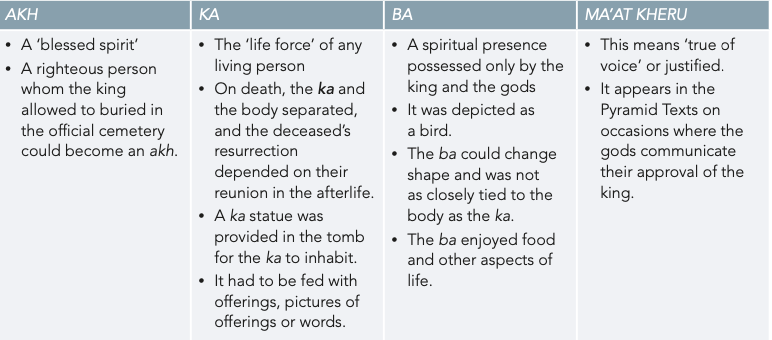
Royal afterlife beliefs:
· Concepts developed in the Old Kingdom: the stellar, the solar and the Osirian cults.
· Stellar cult – originated in 3rd Dynasty and identified with King Djoser and his step pyramid. It was believed the deceased king would ascend to heaven to be with the ‘imperishable stars’ (visible in the northern hemisphere that never set).
· Solar cult – dominant in the 4th and 5th Dynasties. The deceased king travelled to heaven via the rays of the sun and joined the sun god Re in his solar barque making its daily journey from dawn to dusk across the heavens.
· Osirian cult – appeared in late Old Kingdom. Deceased king joining Osiris in the underworld.
· Less evidence for afterlives of royal women; wives and mothers of kings most important; some queens given their own small pyramids near those of the kings; other women usually included in the burials of their male relatives.
Afterlife beliefs of the nobles:
· Depended on their association with the king for their afterlives.
· Presence of food and drink in some tombs and their representations on walls suggest belief in an afterlife where these things would be necessary.
· It is thought that the dead stayed close to their tombs
· Some tombs have ka statues which seem to be passing through a false door of the tomb to receive offerings, suggesting the belief that the ka could leave the burial chamber.
· Detailed scenes of daily life decorated the walls of tombs suggesting that an afterlife resembling the real life of the deceased was expected.
· The absence of gods in these tomb scenes suggests that these gods were reserved for royalty.
Afterlife beliefs of the lower classes:
· Lack of substantial evidence making it difficult to know.
· Shallow graves located near the tombs of the nobles, so it is possible that they believed or hoped their kas would be able to share the offerings brought to those tomb owners.
· Very small number of tombs for women. Archaeological evidence of women’s afterlives limited.
Pyramid Texts:
· Majority of our knowledge comes from series of spells and prayers known as the Pyramid Texts.
· Found inscribed on the burial chamber walls of the kings
· The utterances or spells that make up the texts dealt with the protection of the deceased king’s remains, the reanimation of his body after he died and his journey to heaven where he became a god.
· Ascent would take place via ramps, stairs and ladders, or even flying on the smoke of burning incense.
· Some queens had Pyramid Texts inscribed in their burial chambers like Queen Neith.
● funerary practices, for example burial sites, forms of burial, ceremonies, and their relationship to religious beliefs and social status (ACHAH144)
Funerary practices:
· Social class determined the nature and quality of the burial
· Remains often mummified, funeral held and the deceased was buried in a tomb.
· Kings would be provided with a pyramid
· Nobles built mastaba tombs (bench-shaped) with varying types of chapels and accompanying features.
Mummification:
· Sources for mummification include tomb inscriptions and actual remains.
· The practice was very different from the New Kingdom.
· Theorised mummifications origins dated back to 3400 BC like with ‘Ginger’ (a naturally mummified male using the sand).
Techniques:
· Early attempts focused on wrapping the body and covering it in plaster.
· By the 3rd Dynasty other techniques had appeared.
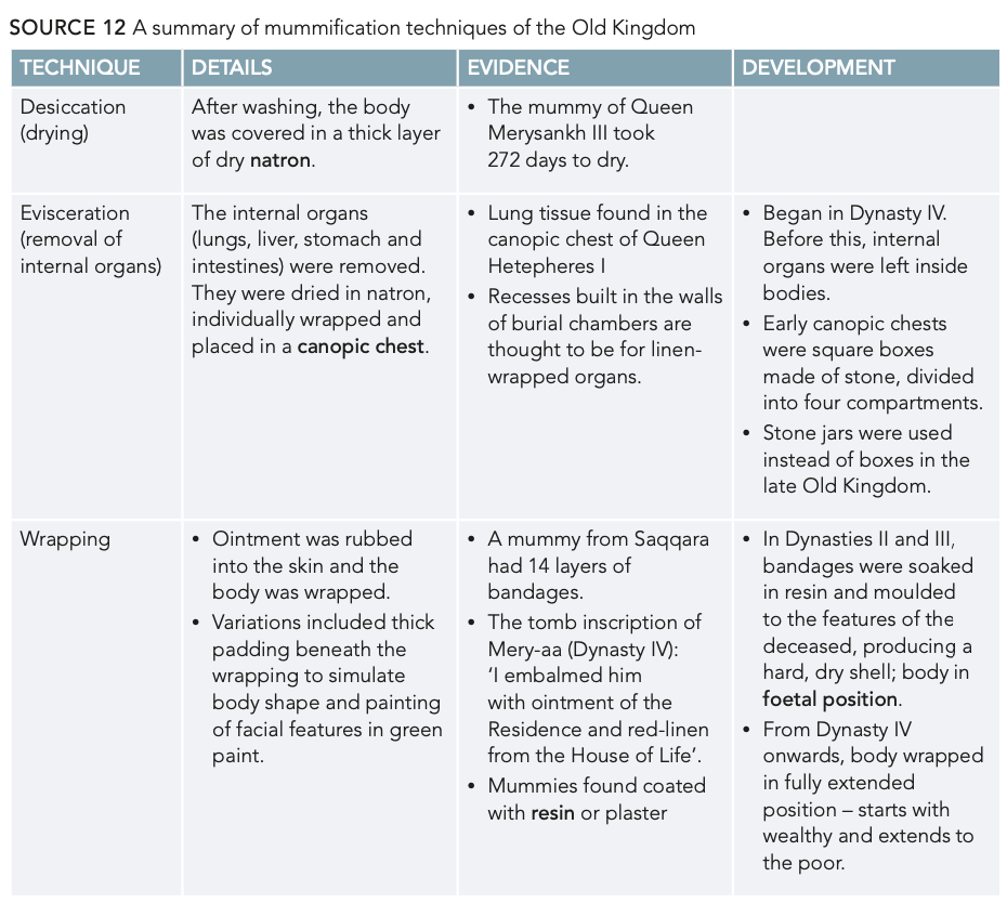
Funeral:
· Royal funerals different form nobles
· All tombs, royal and non-royal, were located on the west bank of the Nile, while the living occupied the east bank. (because the sun rises in the east and sets in the west – reflecting the dead and the living). This meant that the first step of the funeral was to travel across the river.
· Can gain good understanding of the nobles’ funerals from reliefs found in tombs.
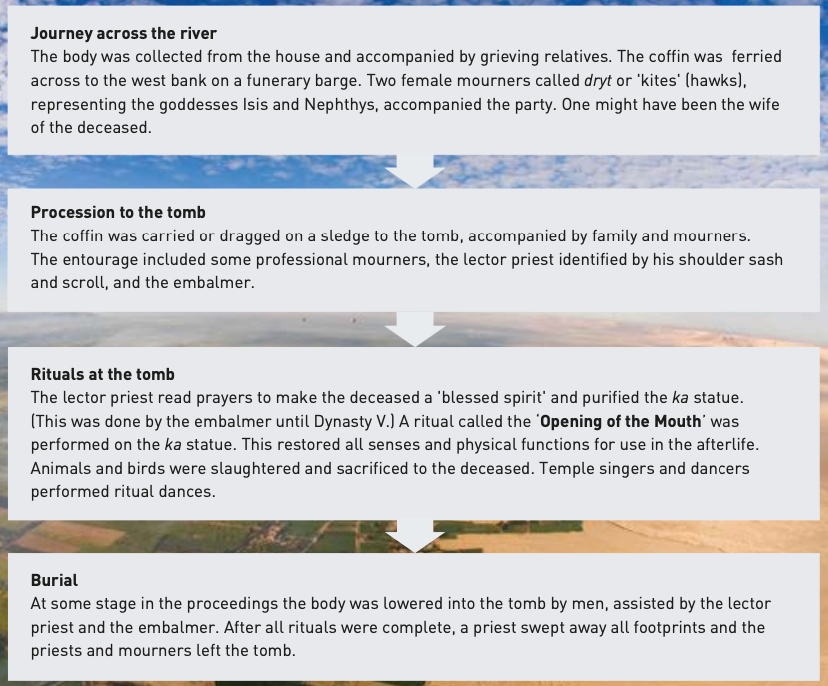
Rock-cut tombs:
· Near the end of the 4th Dynasty, some nobles living in areas with cliffs and outcrops of rock-built rock-cut tombs.
· E.g., the tomb of Queen Merysankh III
· Tended to be smaller than normal mastabas but lasted longer
· Same components as a mastaba tomb and decorated with carved and painted reliefs.
· Sometimes gypsum or mud plaster was used to provide a smooth, sable surface for carving and painting.
· The occurrence of these tombs increased in the 5th Dynasty when some government officials moved to the provinces.
Tomb decoration:
· Developed more in the 5th and 6th Dynasties because of increasing wealth for officials of the King’s bureaucracy.
· Used to be simple representations of tomb goods but changed to elaborate depictions of the tomb owner engaged in the activities of his profession and overseeing the daily lives of his family and servants.
· E.g., Saqqara tomb of Ptah-hotep, a vizier of the 5th Dynasty.
· Was thought that through these reliefs the owner could relive their joys of life on earth through the magical coming to life of the scenes.
· The repetitive scenes of animals being butchered, food being brought to the deceased, and the tomb owner himself or sometimes herself seated before tables piled high with food were expected to provide for their needs for eternity.
Pyramids of the kings:
· Age of the pyramids began in the 3rd Dynasty under the reign of Djoser.
· The monumental tomb structures were expressions of power and status of the kings and their relationships with the gods.
· The experimentation and innovation by Imhotep of these pyramids set up the pattern for the pyramids of Giza to be built in the 4th Dynasty
· Factors set in that caused the decline of pyramid building in the 5th and 6th Dynasties and the end of the Old Kingdom itself.
· Imhotep came up the idea of stacking several mastabas to form a pyramid structure to make the step pyramid.
· Imhotep also thought to build in stone which enabled the eventual construction of the pyramids of the 4th Dynasty and culminating in the Giza pyramid complexes.
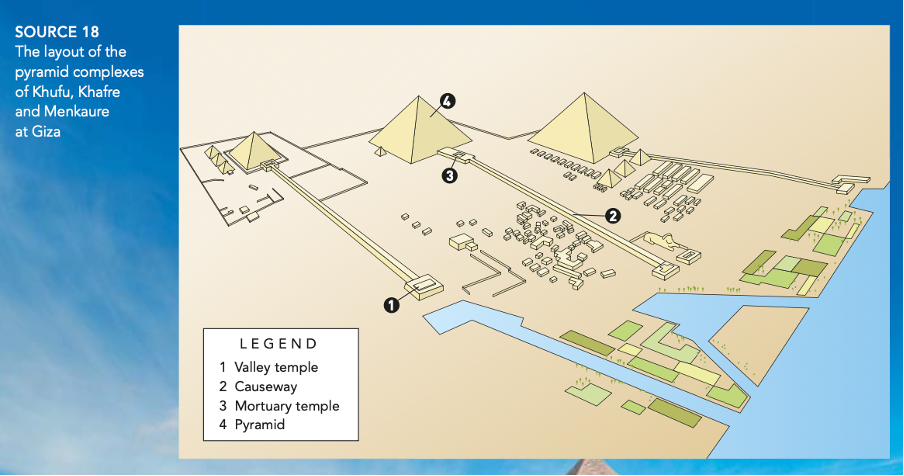
The mortuary complex:
Included a number of buildings designed for the burial and maintenance of the king’s mortuary cult. Including:
· A valley temple located on the banks of the Nile for the reception of the coffin from the funerary barque
· A covered causeway along which the king’s coffin was dragged to the pyramid
· A mortuary temple for the performance of funerary rituals; these were originally on the northern side of the complex, later located on the eastern side.
· The pyramid containing a burial chamber for the king’s sarcophagus.
● evidence of continuity and/or change
Tombs of the nobles:
· The mastaba tombs of the Old Kingdom nobles had developed from the rectangular, house-like structures built by the king’s officials in the 2nd Dynasty.
· Many of the mastaba tomb’s features changed over the Old Kingdom period.
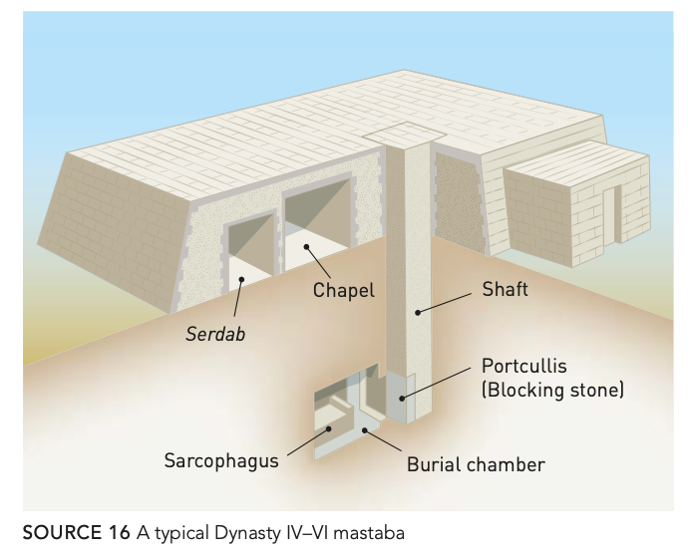
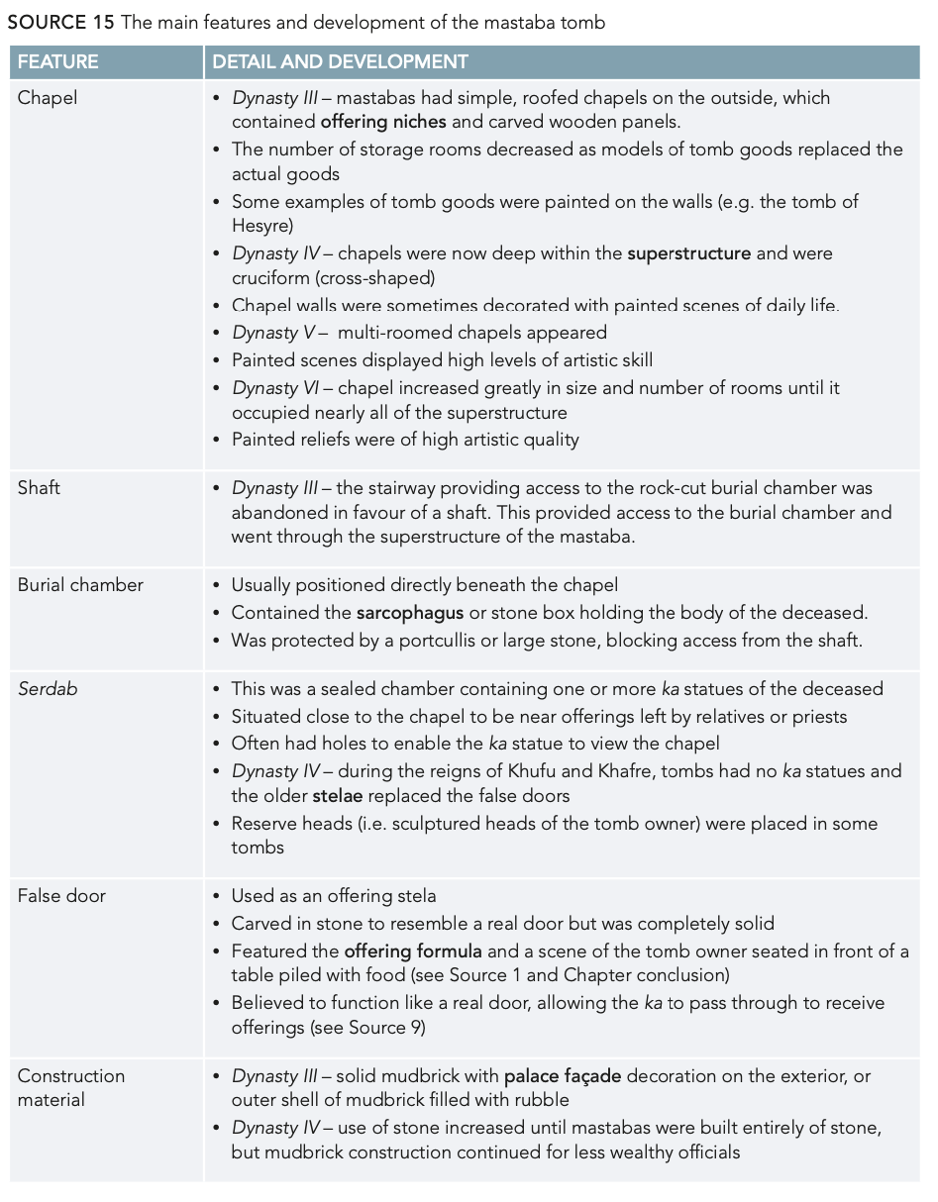
Tomb decoration:
· Developed more in the 5th and 6th Dynasties because of increasing wealth for officials of the King’s bureaucracy.
· Used to be simple representations of tomb goods but changed to elaborate depictions of the tomb owner engaged in the activities of his profession and overseeing the daily lives of his family and servants.
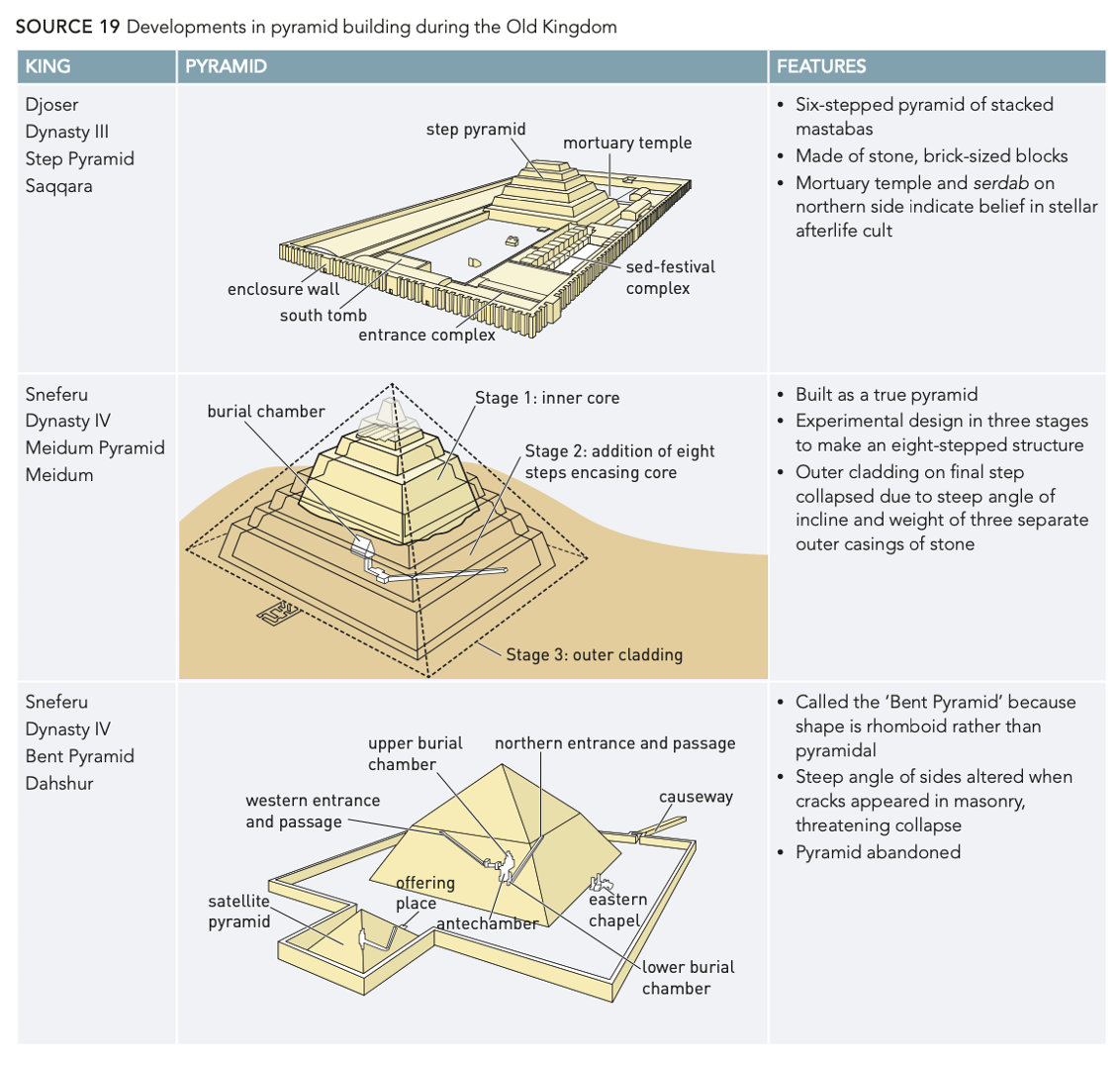
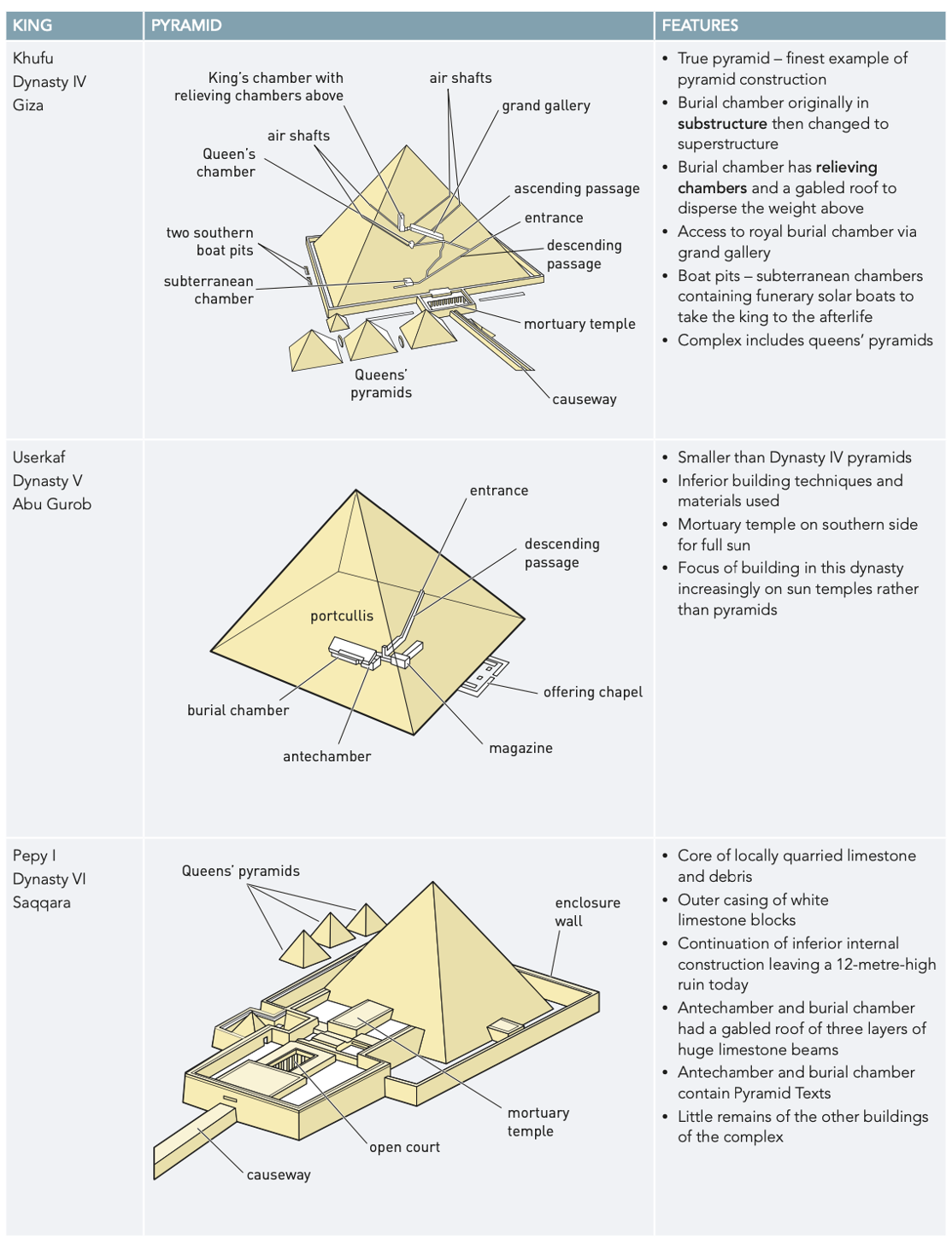
WEAPONS & WARFARE IN ANCIENT ASSYRIA - physiological warfare??
● the nature of the sources for weapons and warfare (ACHAH125)
The sources for Ancient Assyrian Warfare are both archaeological and written.
19th & 20th century archeological excavations revealed the biggest cities in Assyria; Nimrud, Nineveh & Khorsabad.
These excavations found objects such as cylinder seals, bronze sculptures, wall paintings & ivory carvings. All of these give us an understanding of religious beliefs and military events. One of the biggest proofs are the reliefs on the walls in palaces. Huge panels were carved to depict the lives of kings, including the battles they fought in.
Some kings kept libraries of written records of their war campaigns on clay tablets. These were often in the form of annals, and written in cuneiform text.
Archaeological:
· The archaeological excavations in the 19th and 20th centuries revealed the cities of Assyria: Nimrud, Khorsabad and Nineveh. These held artefacts like cylinder seals, bronze sculptures, wall paintings and ivory carvings, which provided information about Assyrian religious beliefs and military events.
· Huge panels of alabaster were carved in relief which depicted the lives of the kings and their military exploits, giving us information on the Assyrian army and its campaigns.
Written:
· King lists, chronicles, royal letters, legal and administrative texts, and literary and scholarly works.
· In the form of annals and inscribed in cuneiform text were clay tablets with records of the military campaigns and activities of kings at libraries in cities like Nimrud and Nineveh.
· E.g., the Taylor Prism from the library of Ashurbanipal at Nineveh was a hexagonal clay prism listing campaigns of Sennacherib until the start of his final war against Babylon. Also has details on siege of Lachish and a record of the tribute received from Hezekiah, King of Jerusalem.
● the composition and role of armies and/or navies and changes in forms of weapons and military tactics (ACHAH126)
ARMIES
In the beginning of Assyrian warfare, all military activities were carried out by a part-time army. Their campaigns were carried out by conscripted farmers & agricultural workers during the off season of the farming.
The first standing army was formed by Tiglath-Pileser III in the Neo-Assyrian period. From his reign on, soldiers were hired from the providences and sourced from the vassal states as an obligation to the king.
The infantry included foreigners and the cavalry & chariot divisions included primarily Assyrians.
Specialist Corps were a division
WEAPONS
MILITARY TACTICS
Through the Assyrian king and state being occupied with warfare, the Assryian army developed a degree of military expertise that surpassed all of its neighbours. The army marched out on annual campaigns, often led by the king and started in spring.
Composition of armies
· Units such as infantry, archers and slingers, chariotry, cavalry, commissariat, war artists and scribes.
· Engineers were unique in this army as they invented and constructed siege engines, dug tunnels, bult bridges, and developed supply and communication systems.
· Organisation of Assyrian army: King of Assyria (always represented as victorious commander of his troops), Chief General or Turtanu (commanded several provincial divisions: 100,000 to 250,000 men), Rab Shaqe (commanded one provincial division of a number of kisri (15,000 men), Rab Kisri (commanded one kisri of 5-20 squads), Rab Eserti (commanded a squad of 10 men).
Infantry
· The mainstay of the army
· Light and heavy corps determined by amount and type of armour worn
· Assyrian army notable for its use of iron weapons rather than bronze which were used by their opponents.
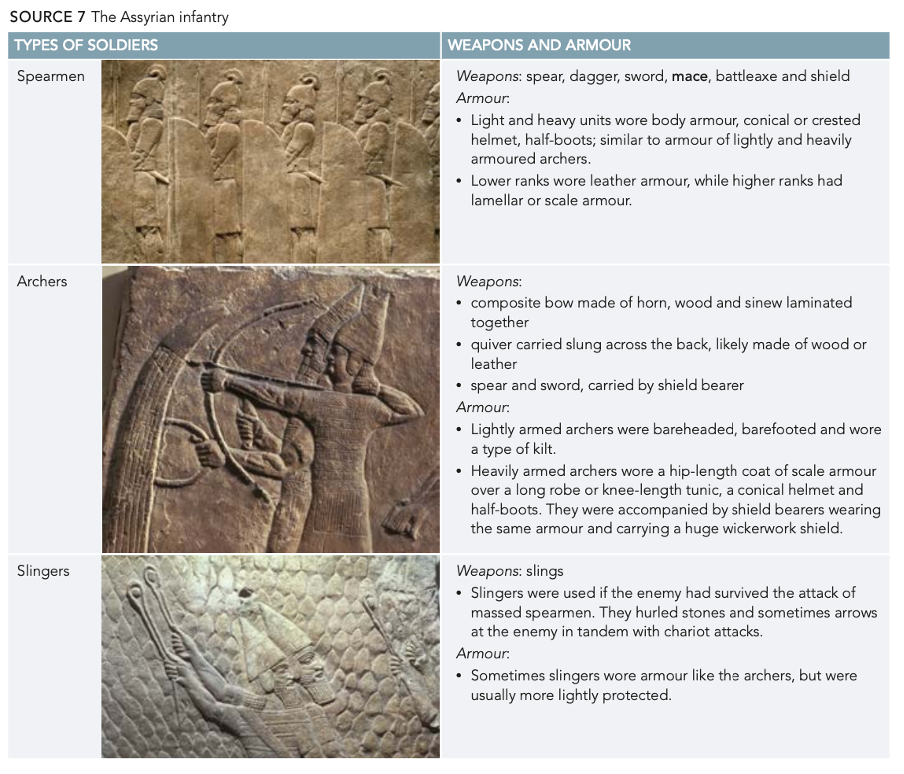
Specialist corps:
Either supported the Assyrian army or were significant in their own right.
Chariotry:
· Made up the elite corps of the Assyrian army
· shooting from a moving chariot either required large skill but sometimes the archer dismounted to fire from the ground.
· Horses tended to be untouched by the enemy as valued as war booty.
· Heavier chariots also used to drive through enemy formations to confuse and disperse the infantry.
Chariots were -
· two-wheeled
· open backed
· drawn by two or more horses
· initially was light and had a charioteer (driver) and an archer
· heavier chariot had a driver, archer, and one or two shield bearers
Cavalry:
· horses not used much until time of Sennacherib
· riders mostly archers and had attendants to hold horse steady so the archer could shoot.
· Horsemanship skills later advanced as archers shown riding in reliefs unattended
· Horses protected by fabric armour for protection against missiles shot from slingers
· Cavalry chargers employed to break through enemy lines while mounted spearmen chased and rounded up defeated troops.
· Main function of cavalry was to protect infantry from enemy so archers and slingers could operate unhindered.
· Cavalry became core of Assyrian army and horses were vital war resource and were obtained from tribute paid by vassal states, horse-breeding programs and raids against horse-owning enemies like the Scythians.
Engineers:
· Responsible for carrying out range of tasks essential for besieging an enemy city or stronghold
· Built the roads and camps for the army on the march
· During a siege they built walls around the city, filled with moats and erected ramps for the deployment of troops and battering rams
· Tunnelled under the enemy city’s walls and built scaling ladders and bridges for frontal assaults
· Bridges could be pontoons or rafts tied to inflated animal skins
· Troops and horses sometimes swam across rivers using inflated goatskins to stay afloat.
● the life of soldiers, their training and the conditions of service (ACHAH127)
Soliders could fall under several units; Infantry, Slingers, Archers, Charitory, Cavalry, the Commiserate, war Artists & scribes.
Conditions of service:
· Couldn’t find much on this but:
· Tiglath-Pileser III was created the world’s first professional standing army (an army of full-time professional soldiers
· There were also soldiers hired from the provinces and sourced from vassal states as part of their obligations to the king.
· The infantry sometimes included a large number of foreigners
· The chariot divisions were mostly Assyrians
Training:
· Couldn’t find anything on this
· I guess since there was a standing army, these soldiers trained constantly as they dedicated their life to the military.
The life of soldiers:
· The army marched out on annual campaigns led by the king which started in spring, after the customary royal inspection and performance of religious rites.
· The army would head to the frontier, collecting extra troops as it went along.
· Supplies of food in the form of barley were carried and issued as rations. For all other supplies the army lived off the land and local rulers were expected to provide supplies as demanded.
· If the campaign went longer than expected, the army would spend winter in some suitable and friendly territory.
● the significance of the military within society (ACHAH128)
Assyrian society revolved around their military might.
· Assyrian society was tribal in nature, and protection of the family was of the highest importance in all social groups. Protection of the nation was of importance.
· The Assyrian king and state were primarily occupied with warfare.
· Over time the Assyrian army developed a degree of military expertise that surpassed that of all of its neighbours because the Assyrians were so occupied with the military aspect of their nation.
· They created the world’s first professional standing army, people who were full-time professional soldiers that dedicated their life to the military.
· The Assyrian army didn’t just attack other nations when threatened, they had annual campaigns that started every spring.
· Conquering and maintaining control of vassal states was also of importance.
● the evidence for at least ONE key military encounter, including military strategy
THE SEIGE OF LACHISH
The Assyrians began there attack by using arcgers to clear the defenders on the battlement, they then built a ramp to reach the city walls with their seige machines
They released fire on lachish that left a thick layer of charcoal
Archeologists have found many slings and arrows, to prove their were many battles
There are detailed reliefs in Nineveh of slaves being moved, leaders being impaled and archers shooting arrows. This battle is also recorded in the Bible, and on the Taylor Prism.
The Siege of Lachish:
· King Hezekiah of Jerusalem in Judah rebelled against the Assyrian king Sennacherib and refused to pay tribute.
· Sennacherib responded by a campaign to destroy Jerusalem but his route was blocked by the city of Lachish
· Occurred in 701 BC
Evidence -
· Depicted in reliefs on the walls of Sennacherib’s palace at Nineveh and he had written records, and it was mentioned in the Old Testament books of 2 Kings and 2 chronicles.
· Archaeologists have found large numbers of sling stones and arrowheads, indicating the intensity of the fighting.
· Also evidence from modern archaeological excavation.
Military strategy –
· Lachish protected by: committed defenders and a well-fortified stronghold. They had two massive walls made of stone, one in the middle of the hill and one at the top, and had battlements made of mudbrick at the top of the walls.
· Assyrians surrounded the city and used archers to clear the battlements
· Then built a big ramp to reach upper city wall to deploy siege machines with battering rams to break the wall.
· The defenders of Lachish built a counter-ramp behind the wall.
· Assyrian archers on the ground covered an assault by the infantry using scaling ladders.
· The Lachish defenders attempted to set fire to the siege engines and to use rocks tied to ropes to smash them but the defences eventually collapsed and the Assyrians broke into Lachish.

Significance
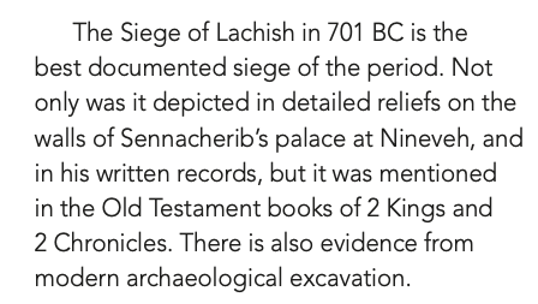
The main aims of Assyrian military strategy over a long period of time included:
· Securing the borders of the empire in the north and south
· Establishing control over areas that were not completely subdued
· Suppressing rebellions in vassal states.
Two main features of Assyrian military strategy were deportation and colonisation. Psychological warfare was also used where serious cases of rebellion resulted in looting and the enslavement or slaughtering of the population in gruesome ways (of the city that the Assyrians were trying to defeat) depending on how seriously the city rebelled.
Siege warfare involved the surrounding and blockading of an enemy stronghold to force it to surrender.
Deportation was a tactic of psychological warfare where the whole population of a city the Assyrians conquered were deported from their homelands and transported to parts of the empire to live and work.
Colonisation was similar to deportation, having groups of Assyrians to be colonists and be moved from place to place. The aim was to have Assyrian bases throughout the conquered lands.
18.4 Profile Questions on Lachish
He took lots of Hezakiahs goods and
That hezakiah gave him moneys, there were fences in laodecia
Source 17 gives us a recount of the battle, Source 18 tells us the impact after
I think that source 18 is more reliable, but Source 17 also has a strong narrative of the battle that is backed up with physical evidence, like the slingshots & arrows
● the political, economic and social impact of warfare and conquest (ACHAH129)
Political: The king was the most powerful person, wielding political and religious power as both king and high priest of Ashur, the state god.
Social: Below the crown prince and governors were the nobles and military officers and their families, meaning people of military officers, who unlike in other societies, were of the same importance as nobles.
Economic: warfare allowed the Assyrians to gain tribute from vassal states.
● evidence of continuity and/or change
Horses
Chariotry:
· initially was light and had a charioteer (driver) and an archer
· heavier chariot had a driver, archer, and one or two shield bearers
· the later dated from reforms to the army carried our during the reign of Sargon II.
Cavalry:
· riders mostly archers and had attendants to hold horse steady so the archer could shoot.
· Horsemanship skills later advanced as archers shown riding in reliefs unattended
YEAR 11 FINAL EXAM STRUCTURE
Three Sections
Section 1 (30 Minutes) The - Bog Bodies only here
Part A - 15 Marks (Multi Choice & Short Answer) (attempt questions 1-8)
Part B - 10 Marks (Source Booklet) (One question)
Section 2 (1 Hour) - Investigating Ancient History Case Study
Part A - (attempt all parts of question 11) Case Study: Tutankhamuns Tomb 25 marks (a (5),b (8, 1 page) & c(12 marks page ½ extended respone)) ONLY ATTEMPT
Part B - Case Study : Palmyra (Question 25, a (1), b (4), c (5, 1 page), d (15, page ½ extended response with reference to source & other information) Connections with other nations, trade routes, war, what made changes with war, who were their rulers.
Section 3 (30 Minutes) - FULL ON ESSAY (STUDY BOTH TOPICS, BE ABLE TO WALK INTO THE EXAM & WRITE AN ESSAY ON EITHER)
One Question (25 Marks) - Key features. Weapons & Warfare or Death & Funerary Customs.
Question 31, Key Features Weapons & Warfare Assyria - asks for a particular thing to focus on, you have one option to write about. THE SEIGE OF LACISH!!!!!!!!!!
Question 32, Key Features Death & Funerary Customs Old Kingdom Egypt. Guessing it would either be religious things or their mummification process
USE PEEL PARAGRAPHS FOR ESSAY
In regard to…